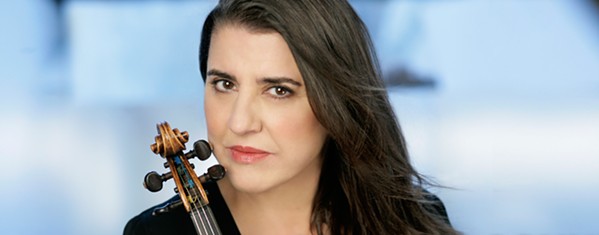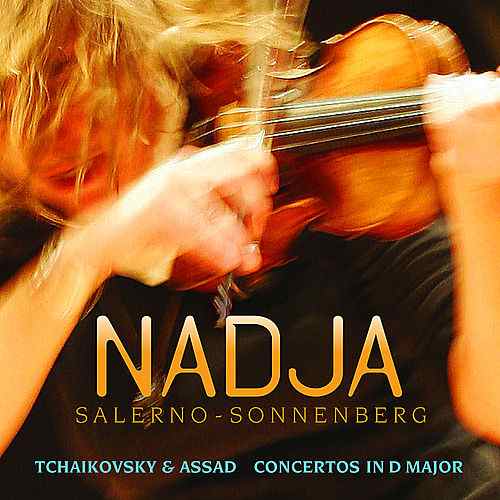VIOLIN CONCERTO
Commissioned by Nadja Salerno-Sonnenberg | c.a. (23 minutes)
RENTAL INFORMATION
Please contact Osvaldo Sheronick for quotes, perusal scores and more information about this work. You may also use the website's contact form. (This work is published by Virtual Artists Collective)
Bb Clarinet
Oboe
Bassoon
F Horn
C Tpt
Timpani
Perc. 1*
Perc. 2**
Solo Violin
Strings
Triangle
Tambourine
Susp. Cym
Triangle
Castanets
Snare drum
Vibraphone
The concerto for violin and orchestra began with a conversation during the summer of 2003, when my father Sergio Assad, my uncle Odair Assad and Nadja Salerno-Sonnenberg were performing as a trio across the United States. My father had already been writing some incredible pieces for Nadja and them (the Assad brothers) for a long time. I had just graduated from the Chicago College of Performing Arts and was about to start work on my Master’s degree at the University of Michigan in Ann Arbor, majoring in composition.
One evening after the concert, the four of us were conversing about music, and I mentioned that I had no idea what to do for my Master’s thesis. To my surprise, Nadja said "why don't you write something for me to play?" I cannot put into words how excited I was when I heard her saying this, and it is still hard for me to believe it is happening.
I then started listening to her playing and watching videos of her performances. I went through all of the published and unpublished materials that I could get my hands on. Nadja was very kind to give me those recordings and to show me so many of the things she has done (whether accompanied by an orchestra, or by smaller ensembles). We also had several conversations about the concerto, where I would ask her simple things such as what she liked and did not like about form, development, rhythm and melody. These conversations gave me very good ideas and guidelines as I continued to write. During this period I also went to several of Nadja's live concerts, one of which I remember meeting conductor Marin Alsop, whose personality and musicianship deeply inspired me as well. Those were great times, which I shall never forget.
I wrote the entire piece backwards, starting with the third movement based on the notes I had taken from the interviews with Nadja and a tiny theme I had written for a prelude and fugue a couple of months earlier. For some strange reason, the third movement was going extremely smoothly. The ideas were flowing, and I somehow knew musically where to go; but this was before I finally realized that I still had two movements to write, and this whole process had already taken almost an entire semester! It was scary for me, and I had to stop for a while and restart the thesis after the semester was over. It was summer time, and once again I went on our with Nadja, my dad, and my uncle.
When we were all together again, I remember showing Nadja a slow, quasi melancholy song that I wrote for piano and voice called Ondas (waves). To my surprise she requested this song to be the main theme of the second movement. She also said that I'd better stay away from writing too many pizzicatos for her to play. I guess she doesn't love them all that much. My only challenge then, would be to get started on the first movement and for a moment I felt as if I had gone back to the beginning all over again. However, this did not last very long. Upon spending more time with the trio, listening to their musical and social interaction, I realized that I had been forgetting one of the most important elements in life. The key for expressing feelings and emotions, which was as simple as spending more quality enjoying myself with people that I love. Yes, I had locked myself in an apartment for almost a year and nothing was really coming out of my head.
Then I started to pay attention to a lot of things I had never really thought of before, such as observing people's behavior. I would just sit there and look around, listen and not comment on anything just to get an idea of what was surrounding me. I noticed, too, so much of Nadja's seriousness about her art and music as well as her playfulness and good spirit that I based the first entire movement on that idea: a person who has such an incredibly profound and kind soul, who is also so extremely lively and funny.
The first theme of the first movement starts off with a lyrical melody that carries many different motifs, that can be transformed pretty much in any way, but that does not lose its prime form or character; which is what I have had in mind for the kind of person that Nadja is. In other words, she can be so many different ways, but her beautiful essence is one. Following this same principle, I wrote a contrasting second theme that would characterize the fun and playful side of Nadja which is so much a part of her and could not be neglected. Musically speaking, the melody of the second theme is a simple one, but with harmonic and rhythmic changes that create an interesting layer over the melody.Altogether, I was more than glad to notice the different sides of Nadja's personality, which led me to write a piece that would include all of those element translated, I hope, into a world of sound.
After the summer was over, I went back to Michigan to continue my studies with professors Michael Daugherty and Evan Chambers. We worked very closely and in great detail on every nuance and aspect of the piece, and I am honored to have had their guidance. I was able to finish the piece and graduate from the University of Michigan even before the standard time, and none of this would have been possible if I did not have the chance to be working closely with Nadja the entire time. I am so grateful for this. It is impossible to put into words. Maybe, since this is all about music, it is best to let the piece speak for itself.

"The theater world has an axiom that any given play grows longer in larger performing spaces. Clarice Assad's new Violin Concerto strangely went in the opposite direction: Though its 22-minute duration feels expansive on compact disc at home, the concerto seemed much shorter Thursday at the Kimmel Center with the Philadelphia Orchestra and Nadja Salerno-Sonnenberg. Maybe that's because you wanted more of it. This first major concert work by the 28-year-old jazz-steeped Assad is high on lyricism and charm, not so high on the kind of thematic development that could explore more aspects of her melodic inspiration. Inspired by the Samuel Barber Violin Concerto, Assad's isn't about thematic arguments between soloist and orchestra; it creates a series of abstract, thematically integrated symphonic songs - likely to be dismissed by the cutting edge and embraced by almost everybody else.The wind writing delivers welcome whiffs of Spanish/Moorish influences. The third movement puts a large variety of ideas into the same musical room, alternately making sense of their coexistence and delighting in their lack of it. True to form, Salerno-Sonnenberg was an emotional live wire, which meant everything to the Assad concerto." Sept. 2006
David Patrick Sterns, The Philadelphia Inquirer
"Receiving a standing ovation however, was the musical talent of Nadja Salerno Sonnenberg. Playing a piece specifically written for her by good friend Clarice Assad the young artist blew everyone away. Ms. Assad’s work blended classical music with chamber jazz. Setting her apart from other composers is her creative way of using native rhythm to infuse her music. Thriving on the Brazilian beats of the Concerto for Violin and Orchestra, Ms. Sonnenberg’s interpretation not only showed her musical depth but her onstage presence alluded a confidence felt by all."
Courtney Treadwell, inthespotlight.com
Rocky Mountain News
Sentinel Correspondent




